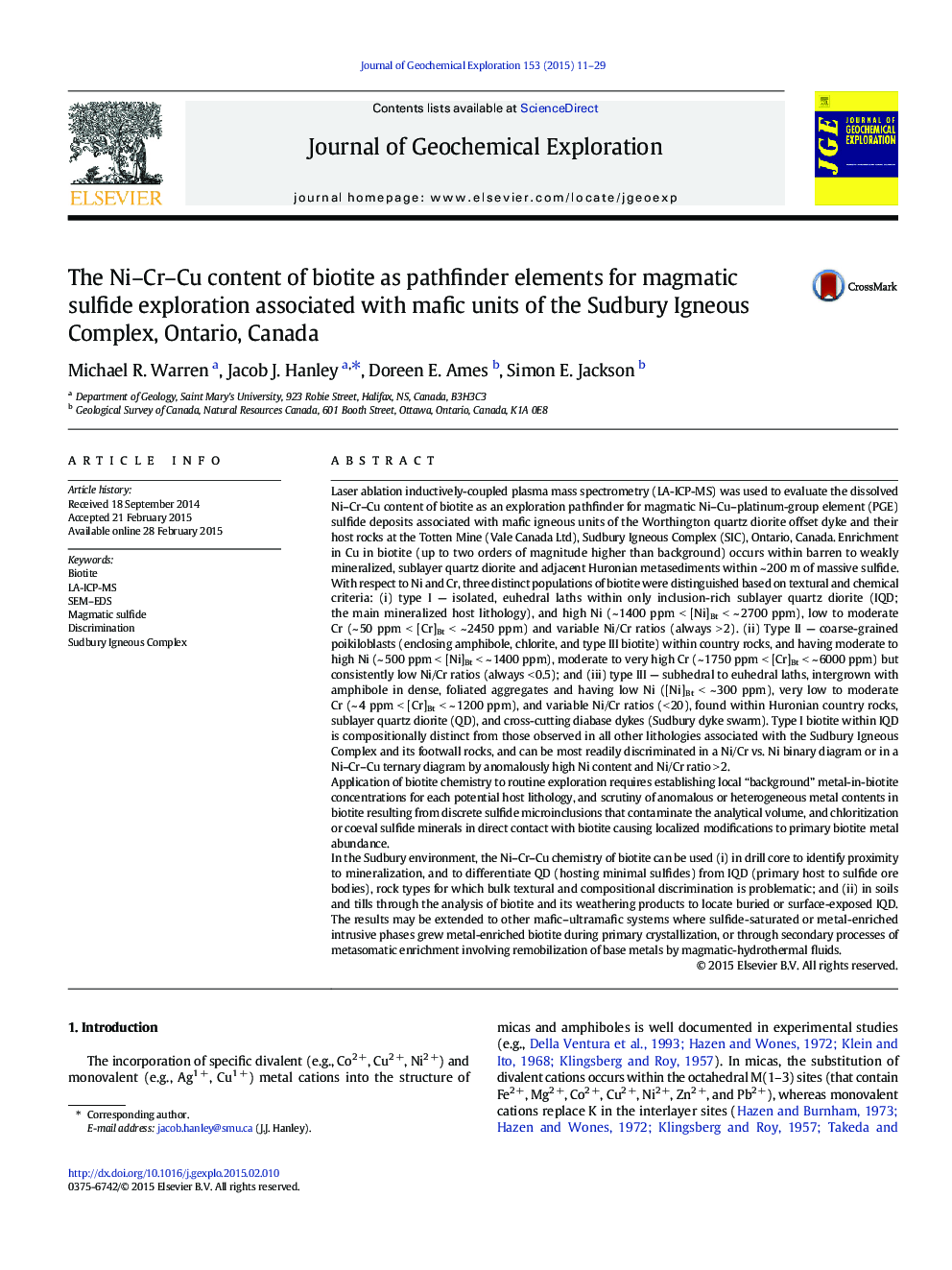| کد مقاله | کد نشریه | سال انتشار | مقاله انگلیسی | نسخه تمام متن |
|---|---|---|---|---|
| 4457152 | 1620906 | 2015 | 19 صفحه PDF | دانلود رایگان |

• We characterized the trace element chemistry of biotite from a Ni-Cu-PGE deposit, Sudbury, Ontario.
• We used in-situ methods (LA-ICP-MS, SEM–EDS) to quantify and map the metal content of the biotites.
• Ni, Cr, and Cu in biotite vary as a function of host lithology and proximity to mineralization.
• Biotite in the ore-hosting lithology hosts ~ 1400 ppm < [Ni]Bt < ~ 2700 ppm and has a Ni/Cr ratio > 2.
• Lithologies cannot be readily differentiated based on bulk rock composition or macroscopic textures.
Laser ablation inductively-coupled plasma mass spectrometry (LA-ICP-MS) was used to evaluate the dissolved Ni–Cr–Cu content of biotite as an exploration pathfinder for magmatic Ni–Cu–platinum-group element (PGE) sulfide deposits associated with mafic igneous units of the Worthington quartz diorite offset dyke and their host rocks at the Totten Mine (Vale Canada Ltd), Sudbury Igneous Complex (SIC), Ontario, Canada. Enrichment in Cu in biotite (up to two orders of magnitude higher than background) occurs within barren to weakly mineralized, sublayer quartz diorite and adjacent Huronian metasediments within ~ 200 m of massive sulfide. With respect to Ni and Cr, three distinct populations of biotite were distinguished based on textural and chemical criteria: (i) type I — isolated, euhedral laths within only inclusion-rich sublayer quartz diorite (IQD; the main mineralized host lithology), and high Ni (~ 1400 ppm < [Ni]Bt < ~ 2700 ppm), low to moderate Cr (~ 50 ppm < [Cr]Bt < ~ 2450 ppm) and variable Ni/Cr ratios (always > 2). (ii) Type II — coarse-grained poikiloblasts (enclosing amphibole, chlorite, and type III biotite) within country rocks, and having moderate to high Ni (~ 500 ppm < [Ni]Bt < ~ 1400 ppm), moderate to very high Cr (~ 1750 ppm < [Cr]Bt < ~ 6000 ppm) but consistently low Ni/Cr ratios (always < 0.5); and (iii) type III — subhedral to euhedral laths, intergrown with amphibole in dense, foliated aggregates and having low Ni ([Ni]Bt < ~ 300 ppm), very low to moderate Cr (~ 4 ppm < [Cr]Bt < ~ 1200 ppm), and variable Ni/Cr ratios (< 20), found within Huronian country rocks, sublayer quartz diorite (QD), and cross-cutting diabase dykes (Sudbury dyke swarm). Type I biotite within IQD is compositionally distinct from those observed in all other lithologies associated with the Sudbury Igneous Complex and its footwall rocks, and can be most readily discriminated in a Ni/Cr vs. Ni binary diagram or in a Ni–Cr–Cu ternary diagram by anomalously high Ni content and Ni/Cr ratio > 2.Application of biotite chemistry to routine exploration requires establishing local “background” metal-in-biotite concentrations for each potential host lithology, and scrutiny of anomalous or heterogeneous metal contents in biotite resulting from discrete sulfide microinclusions that contaminate the analytical volume, and chloritization or coeval sulfide minerals in direct contact with biotite causing localized modifications to primary biotite metal abundance.In the Sudbury environment, the Ni–Cr–Cu chemistry of biotite can be used (i) in drill core to identify proximity to mineralization, and to differentiate QD (hosting minimal sulfides) from IQD (primary host to sulfide ore bodies), rock types for which bulk textural and compositional discrimination is problematic; and (ii) in soils and tills through the analysis of biotite and its weathering products to locate buried or surface-exposed IQD. The results may be extended to other mafic–ultramafic systems where sulfide-saturated or metal-enriched intrusive phases grew metal-enriched biotite during primary crystallization, or through secondary processes of metasomatic enrichment involving remobilization of base metals by magmatic-hydrothermal fluids.
Journal: Journal of Geochemical Exploration - Volume 153, June 2015, Pages 11–29